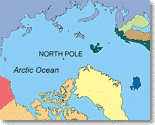 |
 Heartbeat of the Sun Heartbeat of the Sun
|
 |
Solar "Heartbeat" Discovered
Astronomers from the
National Science Foundation's National Solar Observatory
(NSO) have discovered a solar "heartbeat" in the motion
of layers of gas circulating beneath the sun's surface.
Their research shows that some layers speed up and
slow down about every 16 months. This internal motion
provides clues to understanding the cycle of activity
observed on the surface. Understanding the solar cycle
is a fundamental objective of solar astronomy. Every
11 years, the normally quiet sun exhibits a high level
of activity in the form of sunspots, solar flares
and coronal mass ejections. These eruptions can affect
cellular phones, power distribution systems, satellites
and other sensitive technology.
More...
|
 |
|
Motion of Massive Antarctic Ice Berg Causes Another
Immense Berg to "Calve"
The gyrations of an
enormous iceberg that recently broke free of the Ross
Ice Shelf in Antarctica appear to have loosened another
large iceberg, and the "calving" of additional bergs
may continue in coming weeks due to the ebb and flow
of ocean tides. Satellite images of the new berg indicate
dimensions of about 130 kilometers (80 miles) by 20
kilometers (12 miles). The new berg is considerably
smaller at 2480 square kilometers (960 square miles)
than the piece of ice -- now designated as iceberg
B-15 -- which broke off the Ross Ice Shelf earlier
in March.
More...
|
 |
|
 Innovation Effort Seeks to "Grease the Skids"
Innovation Effort Seeks to "Grease the Skids"
The National Science
Foundation (NSF) is seeking to "torque" the link between
fundamental science and engineering discoveries and
their use for innovation through a new program called
Partnerships for Innovation. NSF recently released
the first solicitation for proposals, following a
workshop NSF hosted in early March to solicit inputs
and to plan for a larger November workshop. "This
is an effort to formalize connections between knowledge
and its use, to ensure that taxpayer money does work
at the frontier--but that the knowledge generated
doesn't lie fallow there," said NSF Deputy Director
Joseph Bordogna.
More...
|
 |
|
 NSF
Honors Yale Biochemist Jennifer Doudna with the Alan
T. Waterman Award
NSF
Honors Yale Biochemist Jennifer Doudna with the Alan
T. Waterman Award
The National Science
Foundation (NSF) has chosen a Yale University associate
professor of molecular biophysics and biochemistry
to receive the Foundation's most prestigious prize
for young researchers. Jennifer A. Doudna will be
honored with the 2000 Alan T. Waterman Award at a
National Science Board awards ceremony on May 3 in
Washington, D.C. She is only the third woman to be
so honored, and is the 25th recipient of the award
since its inception in 1976. Doudna's leading work
in structural biology provided an answer to how RNA
can act like an enzyme to catalyze specific biochemical
reactions, and how polyanionic RNA forms a three dimensional
structure. More...
|
 |
|
 Automated
North Pole Station Will Take the Pulse of the Arctic
Ocean
Automated
North Pole Station Will Take the Pulse of the Arctic
Ocean
An international
scientific team supported by the National Science
Foundation (NSF) will establish a research camp at
the North Pole this month. The scientists will use
the camp to lay the groundwork for a five-year project
to take the pulse of the Arctic Ocean and learn how
the world's northernmost sea helps regulate global
climate. James Morison of the University of Washington,
the lead researcher for the North Pole Automated Station
project, said the team will deploy a system of floating
buoys this season and, eventually, devices anchored
to the ocean floor to measure everything from the
salinity of the water in the Arctic Ocean to the thickness
and temperature layering of its ice cover. "This will
be the first time we've put such a congregation of
drifting buoys at the North Pole," Morison said.
More...
|
 |
 
|

